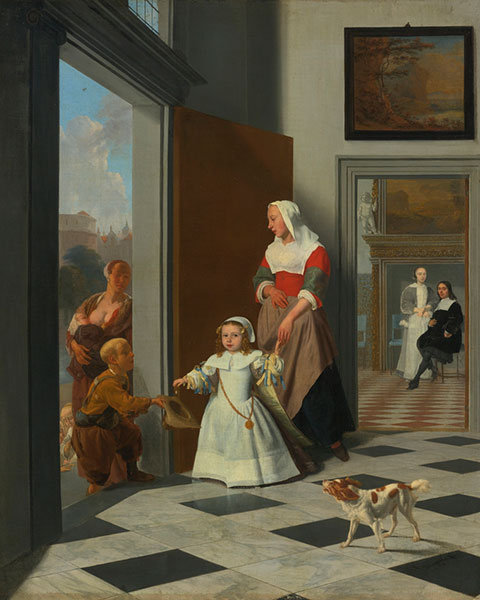The National Gallery of Art, Washington, recently announced its acquisition of an exquisite 17th-century Dutch genre painting.
Everything one would expect from the finest of Dutch genre painting is present within Jacob Ochtervelt’s “A Nurse and Child in the Foyer of an Elegant Townhouse.” In what is arguably one of the artist’s finest works, at center we find a beautifully dressed and well-to-do boy engaging the viewer with his innocent gaze. He gracefully holds the hand of his nurse, whose brilliant red top presents a visual focus. To their left, another boy of similar age, accompanied by his mother, holds out his hat as the other child drops in some coins.
Masterfully executed, no detail has been left untouched, from the marbling in the quintessential checkered floor to the Italianate landscapes that can be seen over the doorways as our view recedes into the home. Ochtervelt has also clearly distinguished the differences in class, seen in the rendering of clothing, complexion, and body language. Quiet and still, the image’s only sense of movement and drama is indicated by the tiny but aggressive spaniel that yaps at the beggars.
Signed and dated 1663, the painting represents the most recent acquisition by the National Gallery of Art in Washington, D.C., and is a marvelous addition to an already world-renowned permanent collection. Director Earl A. Powell III offers, “This wonderful painting complements one of the great strengths of the gallery’s collection: the Dutch painters of high-life genre scenes in the 1650s and 1660s, among them Johannes Vermeer, Pieter de Hooch, Gerard ter Borch, and Gabriel Metsu. Each of these artists capture quiet moments of daily life that entrance and engage viewers, not only because of the sensitivity of their depictions of the human figure, but also because of the way they capture the effects of light and color, and the sheen of fabrics.”
Although he is not quite the household name that, say, Vermeer or de Hooch are, Ochtervelt was a preeminent genre painter during the mid-17th century. After studying in Haarlem from 1645-1650, he established a career in Rotterdam, then relocated to the bustling metropolis of Amsterdam. The gallery reports that in Amsterdam, “Ochtervelt focused on the pleasures of patrician life and leisure-men and -women reading and writing letters, eating and drinking, making music, and playing games. However, his most innovative scenes are those that depict the interactions between the upper and lower classes, often placed at the threshold of an elegant townhouse. Characterized by clarity of light and of color, his paintings display a sympathetic rendering of people from all social classes.”
To learn more, visit the National Gallery of Art.
This article was featured in Fine Art Today, a weekly e-newsletter from Fine Art Connoisseur magazine. To start receiving Fine Art Today for free, click here.
Major Acquisition at NGA








